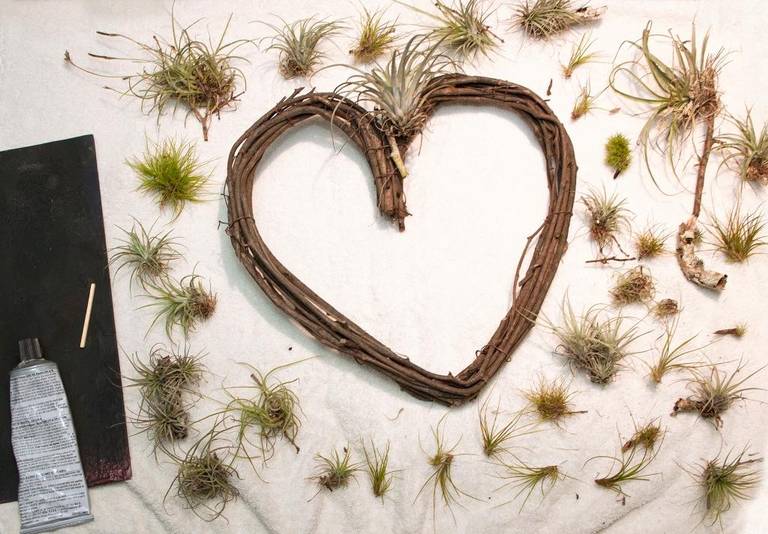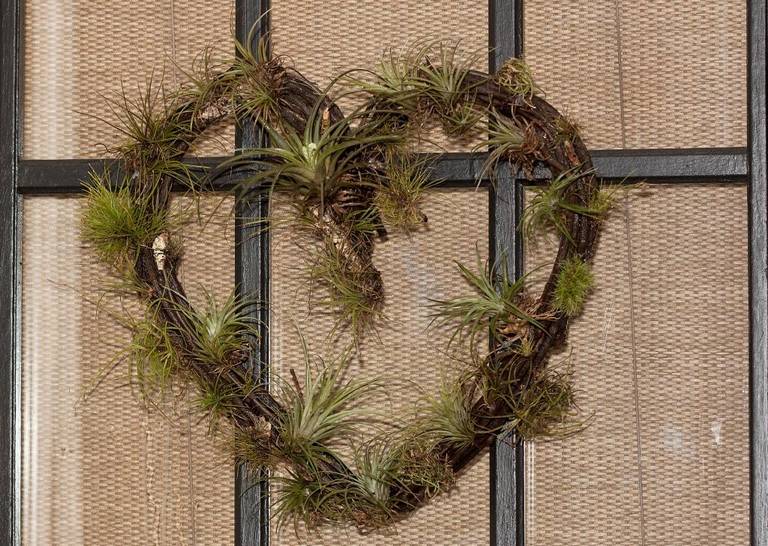How to make a green valentine

BY KENNETH SETZER
As published in the Miami Herald, 1/28/16.
Make a green Valentine’s Day wreath this season. Green in both the literal and figurative sense, this decoration of air plants is alive, requires little to no care, is cheap to make, and has no packaging to discard. Plus, no trips to the mall are necessary when you gather most supplies from your yard — and as the wreath matures, it produces more plants.

Start by gathering tillandsias, wreath form and glue.
Air plants are often featured in design and garden magazines as carefree living things that will thrive anywhere. This isn’t completely true, of course, but air plants, also known as epiphytes, are extremely durable and versatile. Epiphytes are plants that reside on other plants, but they are not parasites and do not extract any nutrients or water from the support plant or tree.
Creative people gather air plants, many in the genus Tillandsia, and arrange them together into “living walls.” It’s a way to garden vertically and make something beautiful using a trellis or similar surface. So for this Valentine’s Day, in the spirit of a living wall, let’s make a heart-shaped wreath of tillandsias.
Tillandsias are in the bromeliad family along with pineapples and hundreds of ornamental bromeliads. There are 16 native tillandsia species (and natural varieties) found in Florida, and about 725 worldwide. The tillandsias you are likely to encounter are ball moss (Tillandsia recurvata), Spanish moss (T. Usneoides), southern needleleaf (T. setacea) and the giant airplant (T. fasciculata).
The ball moss is ubiquitous and looks like a small tumbleweed. It’s often found on the ground, having fallen from an aerial perch on an oak tree or even a power line. A broken branch sends them tumbling, a twig attachment point often still included.
Spanish moss seems to prefer certain neighborhoods. It won’t grow on my oak, but in Coral Gables and other areas it is well established. It’s useful for this project as filler between other air plants, but I am not using any.
The giant or cardinal air plant starts out as a cute little outward-bursting rosette of aloe-like leaves, grayish-green due to the fuzzy trichomes that help it absorb water, lacking the root system that would otherwise do this. Most air plant roots serve more as anchors than as uptake systems.
First, let’s think about collecting the living materials for our wreath. While most governmental bodies have differing and often opaque rules on this, it’s safe to assume you may take nothing from a park besides your own trash. Don’t think “it’s just a plant.” And taking anything from a national park will get you arrested.
You can buy all sorts of air plants from nurseries, but I collected mine from the ground, mostly in parking lots and along streets where they had fallen from trees and probably would have been run over. I never pluck them from trees, even my own. Epiphytes belong in trees, so leave them there. But every time a truck rattles down the street and knocks them free, or when trees are being pruned, you’ll find air plants scattered on the ground.
The wreath frame needs to be open in the center to allow air flow, and it needs to be able to withstand a good soaking. There are heart-shaped wreath frames available in wire metal, but these don’t offer a sufficient surface area, and steel obnes will rust quickly. Crafters may be tempted to make one out of copper, but copper is quite toxic to many plants.
I used a grapevine wreath, made of intertwined, dried vine. Cheap, natural and in different sizes at craft stores, these are ideal structures, with good air flow and drainage.
Glue air plants close to the point that attached them to their tree, but don’t glue the roots. Construction adhesive or jewelry glue work well; they are waterproof and flexible. Simply arrange the air plants evenly until the wreath is covered to your liking, bearing in mind that air plants like good air flow.

The final product, with space for growth and flowering
Once your tillandsia wreath is dry — and gifted — hang it where it will receive good ventilation and strong, filtered light, but not harsh midday sun. Water thoroughly, but gently, hosing it down, or submerge it in water for a few minutes. Remember, tillandsias need to drain and dry quickly; they can’t tolerate constant moisture.
Like love, these tillandsias will grow with a little care and produce offshoots, called “pups.” When they’re about one-third the size of the parent, they can be removed and placed elsewhere while your wreath lives on for years.
